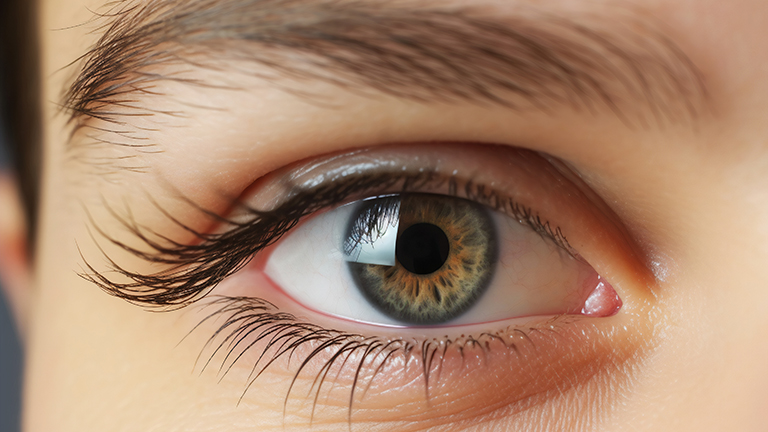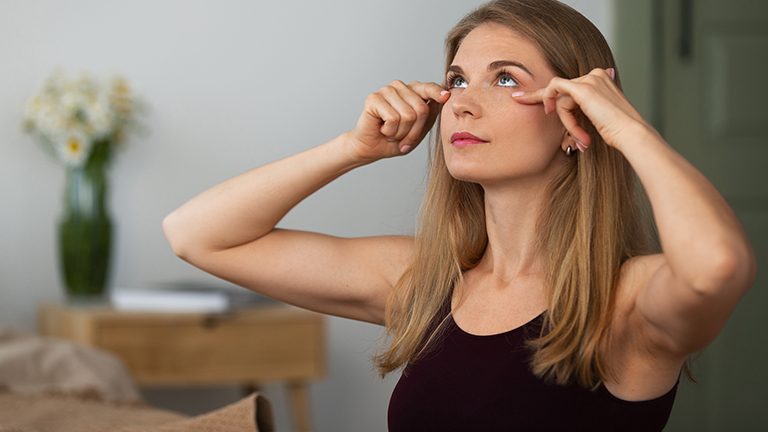In today’s digital age, most people spend several hours a day staring at screens—computers, smartphones, or televisions. While technology has made life easier, it has also given rise to a common problem: eye strain. Eye strain, also known as asthenopia, occurs when your eyes become tired from intense use, often caused by reading, writing, or spending long hours on digital devices. Lets drive in Exercises for Eye Strain Relief.
Common symptoms of eye strain include dryness, headaches, blurred vision, difficulty focusing, and even neck or shoulder pain. This condition is especially widespread among office workers, students, and gamrs who rely heavily on electronic devices.
Practising exercises for eye strain can bring tremendous relief and help maintain long-term eye health. These exercises improve blood circulation, relax the muscles around the eyes, and reduce digital fatigue. They also strengthen the ability of the eyes to focus and shift between different distances, which is essential in preventing computer vision syndrome.
Why Exercises for Eye Strain Are Important
Many people underestimate the importance of regular eye exercises. Just like the muscles in your body, your eye muscles also need relaxation and stretching to remain healthy. Constantly staring at screens without breaks forces the eyes to focus at a single distance for extended periods. Over time, this leads to eye fatigue, blurred vision, and dryness.
Regularly practising eye relaxation techniques not only reduces immediate strain but also prevents long-term issues such as chronic headaches, vision-related anxiety, and even myopia progression in some cases. Furthermore, with the rise of remote work and online education, taking steps to care for your eyes is more important than ever.
[INSERT_ELEMENTOR id=”5108″]
Best Daily Exercises for Eye Strain Relief
Palming Technique for Eye Relaxation
Palming is one of the most effective and soothing techniques to relax your eyes. It works by shutting out light and stimulating the optic nerves through warmth. To do this exercise, rub your palms together until they feel warm, then gently cup them over your closed eyes without applying pressure. Focus on the darkness and take deep breaths. This helps in reducing stress and allows the eye muscles to release tension.
Blinking Exercises for Dry and Tired Eyes
Blinking is an underrated natural exercise that prevents dryness. When staring at a screen, people tend to blink less frequently, which causes dryness and irritation. Practice conscious blinking by closing your eyes for 2 seconds, then squeezing them tightly for another 2 seconds, and finally opening them slowly. Repeat this process several times. It helps moisten your eyes and refresh them.
Eye Rolling and Rotation Exercise
Eye rotation helps improve flexibility and strengthens eye muscles. Sit comfortably, then slowly roll your eyes in a clockwise direction for 10 repetitions, followed by counterclockwise movement. This exercise reduces stiffness and improves overall blood flow to the eyes.
Focus Shifting to Reduce Screen Fatigue
Focus shifting exercises are great for strengthening the eyes’ ability to adjust between different distances. Hold your thumb about 10 inches from your face and focus on it for 10 seconds. Then shift your gaze to an object about 20 feet away and focus again for 10 seconds. Repeat this cycle multiple times. It trains the eyes to adapt quickly between near and far distances.
Near and Far Focus Training
This exercise helps counteract computer vision syndrome. Stand or sit comfortably, then focus on an object very close to you for a few seconds, followed by focusing on a distant object. Alternate between the two for about 5 minutes. This exercise strengthens the ciliary muscles responsible for lens adjustments.
Figure Eight Eye Exercise for Flexibility
Imagine a giant figure eight lying on its side about 10 feet in front of you. Trace the figure with your eyes slowly in one direction for about a minute, then reverse direction. This helps improve eye coordination and flexibility while reducing stiffness caused by prolonged screen usage.
Zooming Exercise to Strengthen Eye Muscles
The zooming exercise is particularly helpful for those who spend long hours reading or working on a laptop. Stretch out your arm with your thumb pointing upward. Focus on your thumb as you slowly bring it closer to your face until it is about 3 inches away, then move it back to the starting position. Repeat 10 times to improve focusing power.
Eye Yoga for Reducing Digital Fatigue
Eye yoga has been practised for centuries in Ayurvedic traditions. It involves mindful breathing combined with gentle movements of the eyes. Techniques such as palming, blinking, eye rotations, and focus shifting fall under eye yoga. Practising these exercises daily improves eye circulation, relaxes nerves, and enhances concentration.
In addition, yoga postures such as the Child’s Pose, Shavasana, and Forward Bend indirectly support eye health by reducing stress and improving blood flow throughout the body. Practising Nadi Shodhana (Alternate Nostril Breathing) also calms the nervous system, which helps reduce tension in the eyes.
Lifestyle Habits Along with Eye Exercises
While eye exercises are highly effective for reducing strain, combining them with healthy lifestyle habits provides the best results. Simple practices such as following the 20-20-20 rule, maintaining proper lighting, adjusting screen position, staying hydrated, and using blue light filters can significantly ease digital fatigue. These habits not only support eye comfort but also prevent long-term damage caused by prolonged screen use. By integrating both exercises and daily eye-care routines, you can keep your vision healthy and stress-free.
Follow the 20-20-20 Rule
One of the simplest yet most effective ways to prevent eye strain is the 20-20-20 rule. After every 20 minutes of screen use, look at an object about 20 feet away for at least 20 seconds. This practice relaxes the eye muscles, reduces digital fatigue, and helps prevent computer vision syndrome. By shifting focus regularly, you give your eyes a much-needed break, keeping them fresh, moist, and better prepared for prolonged screen time.
Maintain Proper Lighting
Proper lighting plays a vital role in reducing eye strain during reading, studying, or working on digital screens. Dim light forces your eyes to work harder, while overly bright light can cause glare and discomfort. Ideally, use soft, natural light and adjust lamps or overhead lights to minimise shadows. Avoid direct screen glare by positioning your monitor at an angle. Balanced lighting helps maintain clear vision, prevents unnecessary squinting, and keeps your eyes relaxed throughout the day.
Adjust Screen Position
Keeping your screen at the right position can significantly reduce digital eye strain. Ideally, your monitor should be placed about 20–24 inches away from your eyes, with the top of the screen at or slightly below eye level. This ensures a natural downward gaze, preventing unnecessary strain on eye muscles and neck tension. Tilting the screen slightly backward also reduces glare. Proper screen alignment promotes better posture, reduces fatigue, and keeps your vision comfortable during extended work hours.
Stay Hydrated
Dehydration is a common but overlooked cause of dry eyes and eye strain. When the body lacks sufficient fluids, tear production decreases, leading to irritation, redness, and discomfort during prolonged screen use. Drinking enough water throughout the day helps maintain natural eye moisture and prevents fatigue. Along with water, hydrating foods like cucumbers, oranges, and watermelon also support eye health. By staying hydrated, you not only refresh your body but also protect your eyes from digital fatigue.
Use Blue Light Filters
Blue light emitted from digital devices is one of the leading causes of eye strain, headaches, and sleep disruption. Prolonged exposure can make it harder for your eyes to focus, especially during late-night screen use. Using blue light filter glasses or enabling night mode on smartphones and computers reduces harmful light exposure and eases digital fatigue. These filters minimise glare, improve visual comfort, and help maintain a healthy sleep cycle while protecting your eyes from long-term strain.
Benefits of Regular Eye Strain Exercises
Practising eye strain exercises on a regular basis offers both short-term comfort and long-term protection for your vision. In the short term, these techniques relieve dryness, reduce headaches, and improve focus by relaxing the tiny muscles around the eyes. Over time, consistent practice enhances eye flexibility, boosts circulation, and helps prevent digital eye strain from becoming a chronic issue. Exercises like palming, blinking, focus shifting, and eye rotations strengthen the ciliary muscles, which are responsible for adjusting focus between near and far objects. This not only improves visual endurance but also reduces the risk of developing symptoms linked to computer vision syndrome. In addition, eye exercises promote relaxation, lower stress, and support overall productivity, especially for students, professionals, and anyone spending long hours in front of screens. By making these simple practices part of your daily routine, you actively protect and preserve your eye health.
Expert Opinions on Eye Health and Strain Relief
Leading eye care experts emphasize the importance of proactive measures to alleviate digital eye strain and maintain optimal eye health. Dr. Sophia Visanji, an optometrist, advocates for the 20-20-20 rule—every 20 minutes, look at something 20 feet away for 20 seconds—to reduce screen-induced fatigue. She suggests using visual reminders, like an hourglass, to prompt regular breaks Real Simple.
The American Optometric Association (AOA) also recommends the 20-20-20 rule and advises on ergonomic screen use, proper lighting, and regular eye exams to combat computer vision syndrome aoa.org.
Similarly, the Mayo Clinic highlights the benefits of wearing glasses prescribed for specific activities, such as computer use or reading, to reduce eyestrain Mayo Clinic.
However, experts caution against over-reliance on blue light filtering glasses. A study published in the Cochrane Database of Systematic Reviews found low-certainty evidence that these glasses do not significantly reduce eye strain or improve sleep quality compared to standard lenses Health. The study’s lead researcher, Dr. Laura Downie, emphasised that the blue light emitted by digital devices is within safe levels and lacks a compelling biological mechanism to cause eye damage or strain.
Incorporating these expert-recommended practices—such as adhering to the 20-20-20 rule, ensuring proper ergonomics, and consulting with eye care professionals—can significantly alleviate digital eye strain and promote long-term eye health.
FAQs on Exercises for Eye Strain
How often should I do exercises for eye strain?
Ideally, you should practice these exercises daily, especially if you use screens for extended periods. Short breaks every 20 minutes are highly recommended.
Can eye exercises improve eyesight permanently?
Eye exercises may not correct refractive errors like myopia or hyperopia, but they significantly reduce fatigue, dryness, and headaches while supporting overall eye health.
Are there risks with doing eye exercises?
Most eye exercises are safe. However, overexerting or forcing movements may cause discomfort. Always perform them gently and stop if you feel pain.
Do children benefit from eye strain exercises?
Yes, children spending time on tablets or computers can greatly benefit. Simple exercises like blinking, palming, and focus shifting are highly effective.
Can eye exercises prevent glasses?
Exercises may not eliminate the need for glasses, but they do help maintain stronger muscles and reduce discomfort associated with long-term screen use.
Final Thoughts on Exercises for Eye Strain
Eye strain is a growing concern in the digital age, but the good news is that simple exercises for eye strain can provide relief and protect your eyes from long-term damage. Incorporating techniques such as palming, blinking, eye rotation, and focus shifting into your daily routine can make a noticeable difference. Pairing these exercises with healthy habits like the 20-20-20 rule, proper hydration, and screen adjustments ensures maximum results.
Protecting your eyes is not just about avoiding discomfort—it is about ensuring better productivity, concentration, and quality of life. Start practising these natural remedies today, and your eyes will thank you for years to come.



